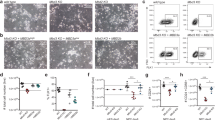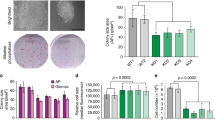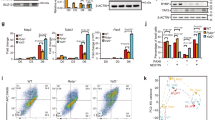Abstract
Nanog and Oct4 are essential transcription factors that regulate self-renewal and pluripotency of ES cells. However, the mechanisms by which Nanog and Oct4 modulate ES cell fate remain unknown. Through characterization of endogenous Nanog and Oct4 protein complexes in mouse ES cells, we found that these transcription factors interact with each other and associate with proteins from multiple repression complexes, including the NuRD, Sin3A and Pml complexes. In addition, Nanog, Oct4 and repressor proteins co-occupy Nanog-target genes in mouse ES cells, suggesting that Nanog and Oct4 together may communicate with distinct repression complexes to control gene transcription. To our surprise, of the various core components in the NuRD complex with which Nanog and Oct4 interact, Mta1 was preferred, whereas Mbd3 and Rbbp7 were either absent or present at sub-stoichiometric levels. We named this unique Hdac1/2- and Mta1/2-containing complex NODE (for Nanog and Oct4 associated deacetylase). Interestingly, NODE contained histone deacetylase (HDAC) activity that seemed to be comparable to NuRD, and retained its association with Nanog and Oct4 in Mbd3−/− ES cells. In contrast to Mbd3 loss-of-function, knockdown of NODE subunits led to increased expression of developmentally regulated genes and ES-cell differentiation. Our data collectively suggest that Nanog and Oct4 associate with unique repressor complexes on their target genes to control ES cell fate.
This is a preview of subscription content, access via your institution
Access options
Subscribe to this journal
Receive 12 print issues and online access
$209.00 per year
only $17.42 per issue
Buy this article
- Purchase on Springer Link
- Instant access to full article PDF
Prices may be subject to local taxes which are calculated during checkout





Similar content being viewed by others
References
Chambers, I. & Smith, A. Self-renewal of teratocarcinoma and embryonic stem cells. Oncogene 23, 7150–7160 (2004).
Rossant, J. Stem cells from the mammalian blastocyst. Stem Cells 19, 477–482 (2001).
Nichols, J. et al. Formation of pluripotent stem cells in the mammalian embryo depends on the POU transcription factor Oct4. Cell 95, 379–391 (1998).
Chambers, I. et al. Functional expression cloning of Nanog, a pluripotency sustaining factor in embryonic stem cells. Cell 113, 643–655 (2003).
Mitsui, K. et al. The homeoprotein Nanog is required for maintenance of pluripotency in mouse epiblast and ES cells. Cell 113, 631–642 (2003).
Takahashi, K. & Yamanaka, S. Induction of pluripotent stem cells from mouse embryonic and adult fibroblast cultures by defined factors. Cell 126, 663–676 (2006).
Okita, K., Ichisaka, T. & Yamanaka, S. Generation of germline-competent induced pluripotent stem cells. Nature 448, 313–317 (2007).
Wernig, M. et al. In vitro reprogramming of fibroblasts into a pluripotent ES-cell-like state. Nature 448, 318–324 (2007).
Yu, J. et al. Induced Pluripotent stem cell lines derived from human somatic cells. Science 318, 1917–1920 (2007).
Takahashi, K. et al. Induction of Pluripotent stem cells from adult human fibroblasts by defined factors. Cell 131, 861–872 (2007).
Kaji, K. et al. The NuRD component Mbd3 is required for pluripotency of embryonic stem cells. Nature Cell Biol. 8, 285–292 (2006).
Wang, J. et al. A protein interaction network for pluripotency of embryonic stem cells. Nature 444, 364–368 (2006).
Wu, Q. et al. Sall4 interacts with Nanog and co-occupies Nanog genomic sites in embryonic stem cells. J. Biol. Chem. 281, 24090–24094 (2006).
Smith, C. L. & Peterson, C. L. ATP-dependent chromatin remodeling. Curr. Top. Dev. Biol. 65, 115–148 (2005).
Workman, J. L. Nucleosome displacement in transcription. Genes Dev. 20, 2009–2017 (2006).
Xue, Y. et al. NURD, a novel complex with both ATP-dependent chromatin-remodeling and histone deacetylase activities. Mol. Cell 2, 851–861 (1998).
Zhang, Y. et al. Analysis of the NuRD subunits reveals a histone deacetylase core complex and a connection with DNA methylation. Genes Dev. 13, 1924–1935 (1999).
Toh, Y., Pencil, S. D. & Nicolson, G. L. A novel candidate metastasis-associated gene, mta1, differentially expressed in highly metastatic mammary adenocarcinoma cell lines. cDNA cloning, expression, and protein analyses. J. Biol. Chem. 269, 22958–22963 (1994).
Ahringer, J. NuRD and SIN3 histone deacetylase complexes in development. Trends Genet. 16, 351–356 (2000).
Shi, Y. et al. Histone demethylation mediated by the nuclear amine oxidase homolog LSD1. Cell 119, 941–953 (2004).
Wu, W. S. et al. The growth suppressor PML represses transcription by functionally and physically interacting with histone deacetylases. Mol. Cell Biol. 21, 2259–2268 (2001).
Boyer, L. A. et al. Core transcriptional regulatory circuitry in human embryonic stem cells. Cell 122, 947–956 (2005).
Loh, Y. H. et al. The Oct4 and Nanog transcription network regulates pluripotency in mouse embryonic stem cells. Nature Genet. 38, 431–440 (2006).
Chen, L. Y., Liu, D. & Songyang, Z. Telomere maintenance through spatial control of telomeric proteins. Mol. Cell Biol. 27, 5898–5909 (2007).
Feng, Q. & Zhang, Y. The NuRD complex: linking histone modification to nucleosome remodeling. Curr. Top. Microbiol. Immunol. 274, 269–290 (2003).
Saitou, M., Barton, S. C. & Surani, M. A. A molecular programme for the specification of germ cell fate in mice. Nature 418, 293–300 (2002).
Bortvin, A. et al. Incomplete reactivation of Oct4-related genes in mouse embryos cloned from somatic nuclei. Development 130, 1673–1680 (2003).
Manavathi, B. & Kumar, R. Metastasis tumor antigens, an emerging family of multifaceted master coregulators. J. Biol. Chem. 282, 1529–1533 (2007).
Gu, P., Le Menuet, D., Chung, A. C. & Cooney, A. J. Differential recruitment of methylated CpG binding domains by the orphan receptor GCNF initiates the repression and silencing of Oct4 expression. Mol. Cell Biol. 26, 9471–9483 (2006).
Bernstein, B. E. et al. A bivalent chromatin structure marks key developmental genes in embryonic stem cells. Cell 125, 315–326 (2006).
Liu, D. et al. PTOP interacts with POT1 and regulates its localization to telomeres. Nature Cell Biol. 6, 673–680 (2004).
O'Connor, M. S., Safari, A., Xin, H., Liu, D. & Songyang, Z. A critical role for TPP1 and TIN2 interaction in high-order telomeric complex assembly. Proc. Natl Acad. Sci. USA 103, 11874–11879 (2006).
Xin, H. et al. TPP1 is a homologue of ciliate TEBP-β and interacts with POT1 to recruit telomerase. Nature 445, 559–562 (2007).
Chew, J. L. et al. Reciprocal transcriptional regulation of Pou5f1 and Sox2 via the Oct4/Sox2 complex in embryonic stem cells. Mol. Cell Biol. 25, 6031–6046 (2005).
Yoon, H. G., Chan, D. W., Reynolds, A. B., Qin, J. & Wong, J. N-CoR mediates DNA methylation-dependent repression through a methyl CpG binding protein Kaiso. Mol. Cell 12, 723–734 (2003).
Acknowledgements
We thank Amin Safari, Xueping Xu and Ok-Hee Lee for technical assistance. We also thank Yaoyun Liang and Xinhua Feng for helping us with quantitative PCR analysis. We thank Brian Hendrich for providing the Mbd3−/− ES cells. This work was supported by NIH grants GM69572 and GM81627 to Z.S and DK73524 to A.J.C. D.L. is supported by American Heart Association. Z.S. is a Leukemia and Lymphoma Society scholar.
Author information
Authors and Affiliations
Contributions
J.L., M.W., Y.Z., P.G., H.X., S.Y.J., J.Q. and D.L. performed the experiments; J.W. and A.J.C. provided reagents; Z.S. provided advice on the experimental design and wrote the manuscript. All authors commented on the manuscript.
Corresponding author
Ethics declarations
Competing interests
The authors declare no competing financial interests.
Supplementary information
Supplementary Information
Supplementary Figures S1, S2, S3, S4, S5, S6 and Supplementary Tables S1, S2 (PDF 748 kb)
Supplementary Information
Supplementary Table S3 (XLS 22 kb)
Rights and permissions
About this article
Cite this article
Liang, J., Wan, M., Zhang, Y. et al. Nanog and Oct4 associate with unique transcriptional repression complexes in embryonic stem cells. Nat Cell Biol 10, 731–739 (2008). https://doi.org/10.1038/ncb1736
Received:
Accepted:
Published:
Issue Date:
DOI: https://doi.org/10.1038/ncb1736
This article is cited by
-
LSD1-mediated demethylation of OCT4 safeguards pluripotent stem cells by maintaining the transcription of PORE-motif-containing genes
Scientific Reports (2021)
-
Bayesian mixture regression analysis for regulation of Pluripotency in ES cells
BMC Bioinformatics (2020)
-
Advances in Pluripotent Stem Cells: History, Mechanisms, Technologies, and Applications
Stem Cell Reviews and Reports (2020)
-
Same agent, different messages: insight into transcriptional regulation by SIN3 isoforms
Epigenetics & Chromatin (2018)
-
In vivo screening identifies GATAD2B as a metastasis driver in KRAS-driven lung cancer
Nature Communications (2018)



